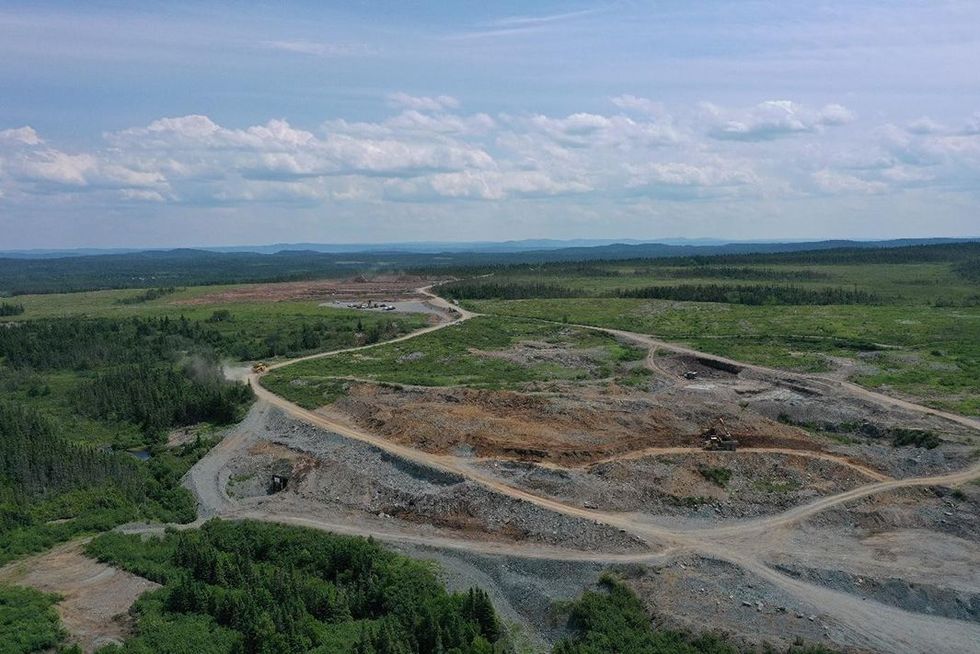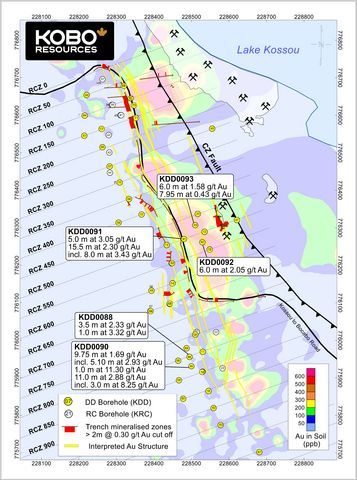Omai Gold Mines Corp. (TSX VENTURE:OMG) ("Omai" or the "Company") is pleased to announce that results from the first two holes of diamond core drilling at the Omai Project confirm that high-grade mineralization continues below the historically-producing Wenot Pit. The 5,000-meter drill program is focused on expanding the open-pit potential of the Wenot Pit that produced 1.8 million ounces of gold at 1.6 grams per tonne to a depth of 190 meters.
Highlights of the drill program:
- Holes 21ODD-001 and 21ODD-002 were drilled from the north side of the pit to test multiple mineralized structures below the Wenot Pit, on section lines approximately 350 meters apart.
- 21ODD-001 intersected multiple high-grade and thick intervals including 19.5 meters (m) of 2.2 grams per tonne (g/t) gold (Au), 13.5 m of 3.6 g/t Au , and 16 m of 9 g/t Au including 1 m of 127.7 g/t Au .
- 21ODD-002 intersected 32.1 m of 3.6 g/t Au including 26.7 g/t (0.4 m) and 25.7g/t (1 m) and an additional intersection further downhole of 18.4 m of 2.2 g/t Au .
- Mineralized zones are both in the basalt sequence as well as the sedimentary sequence close to the Wenot Shear.
- Drilling confirms high-grade mineralization extends at least 100 meters below the historical pit with indications it remains open at depth.
Mario Stifano, Chief Executive Officer of Omai Gold Mines, commented: "We are pleased with our assay results from the first two holes we drilled at Omai, that complement the assay results we announced in February. These results demonstrate that the grades and thicknesses of gold mineralization continue at least 100 to 150 meters below the historically-producing Wenot Pit, and remain open to depth and on strike. We look forward to updating our stakeholders with further results from our 5,000-meter drill program in the coming months."
Table 1: Drill results from holes 21ODD-001 and 21ODD-002.
| Hole ID | From (m) | To (m) | Interval (m) | Grade (g/t Au) |
| 21ODD-001 | 82.5 | 102 | 19.5 | 2.2 |
| 134 | 140 | 6 | 1.0 | |
| 179.3 | 190.3 | 11 | 0.5 | |
| 284 | 286 | 2 | 1 | |
| 310 | 323.5 | 13.5 | 3.6 | |
| 320 | 321 | 1 | 12.2 | |
| 349 | 355 | 6 | 0.4 | |
| 349 | 355 | 6 | 0.4 | |
| 388 | 391 | 3 | 5.4 | |
| 428 | 430 | 2 | 0.5 | |
| 434 | 450 | 16 | 9 | |
| 443 | 444 | 1 | 127.7 | |
| 466 | 468 | 2 | 1.2 | |
| 472 | 485 | 13 | 0.8 | |
| 495 | 515 | 20 | 0.9 | |
| 21ODD-002 | 208 | 214 | 7.1 | 2.3 |
| 208 | 209.5 | 1.5 | 8.9 | |
| 298 | 302 | 4 | 0.7 | |
| 334.9 | 367 | 32.1 | 3.6 | |
| 354 | 355 | 1 | 11.7 | |
| 356 | 356.4 | 0.4 | 26.7 | |
| 356.4 | 357.4 | 1 | 25.7 | |
| 463 | 483 | 20 | 0.3 | |
| 495.6 | 514 | 18.4 | 2.2 |
Note: Intervals are based on a cut-off of 0.3 g/t gold and internal dilution of up to 3 meters. True widths have not been calculated at this time; widths reported represent down hole intersections.
Figure 1: Simplified geology map showing the location of holes 21ODD-001 and 21ODD-002 in relation to the Wenot Pit.
https://www.globenewswire.com/NewsRoom/AttachmentNg/cbcf797a-b58f-499f-827d-f058f057f369
Figure 2: Section 5530 (looking west) showing geology and gold intercepts of hole 21ODD-001 (538 m end-of-hole).
https://www.globenewswire.com/NewsRoom/AttachmentNg/64b5a536-cdad-4f17-a023-8a66f89c8d89
Figure 3: Section 5180 (looking west) showing geology and prominent intercepts of hole 21ODD-002 (526 m end-of-hole).
https://www.globenewswire.com/NewsRoom/AttachmentNg/e10f6361-3c9e-4f21-84b1-47aaf1a2447c
Holes 21ODD-001 and 21ODD-002 were drilled to confirm that gold mineralization continues at depth under the Wenot Pit. The higher grade zones are drilled on sections separated by 350 m, and are associated with sheared structures that host extensional veins. Gold, quartz-carbonate-sericite alteration and pyrite are associated with hornblende diorite intrusions within the basalt units under the pit. A second target type is the contact between the rhyolite dikes and basalts, which host highly sheared zones with strong iron and magnesium carbonate-sericite alteration and sulfides.
Gold grades are significant in both holes. The mineralization proximal to the Wenot Shear has also been confirmed by these holes with 21ODD-002 intersecting 18.4 m @ 2.2 g/t Au within the Lithic wacke close to the highly sheared and altered contact of the Wenot Shear.
Drilling is currently on the south side of the pit and drilling back to the north side. Songela, a well-established Guyanese company, is the drilling contractor. A single rig with two shifts is being used.
Table 2: Hole location and orientation.
| Hole ID | Easting | Northing | Elevation | Dip | Final depth | Start date | End date |
| 21ODD-001 | 305549 | 601805 | 48 | -50 | 538 | 2/4/2021 | 2/16/2021 |
| 21ODD-002 | 305186 | 601874 | 47 | -50 | 526 | 2/17/2021 | 2/27/2021 |
Sample collection, assaying and data management
An experienced technician is stationed at the rig to record hole recovery, core orientation, and related geotechnical parameters. Core samples are collected at 1- to 2-meter intervals for assaying and consist of ½ core. Standards, blanks and duplicates are entered in the sample stream at regular intervals. Samples are sealed in plastic bags and shipped to the Actlabs certified laboratory in Georgetown, Guyana, respecting the best chain of custody practices. At the laboratory, samples are dried, crushed up to 80% passing 2 mm, riffle split (250 g), and pulverized to 95% passing 105 μm, including cleaner sand. 30 g of pulverized material is then fire assayed by atomic absorption (AA). Initial assays with results above 3,000 ppb gold are re-assayed with gravimetric finish. Standards and blanks are with QA/QC specifications.
Qualified Person
Dr. Dennis LaPoint, PhD, is a Qualified Person (QP) under National Instrument 43-101 "Standards of Disclosure for Mineral Projects" and has approved the technical information contained in this news release. Dr. LaPoint is not considered to be independent for the purposes of National Instrument 43-101.
Neither the TSX Venture Exchange nor its Regulation Services Provider (as that term is defined in the policies of the TSX Venture Exchange) accepts responsibility for the adequacy or accuracy of this release.
About Omai Gold Mines Corp.
Early prospectors identified Guyana's vast mineral wealth 130 years ago, and at the heart of the country's gold mining history is the Omai mine: a multi-million-ounce deposit that was once South America's largest producing gold mine. We're building on this past success with new tools, relationships and vision to bring this under-explored gold district back to life, providing a unique opportunity for all stakeholders to participate in value creation.
Avalon Gold Exploration Inc., a wholly owned subsidiary of Omai Gold Mines Corp., holds a 100% interest in the Omai Prospecting License covering 4,590 acres, including the past producing Omai gold mine.
For further information, please see our website www.omaigoldmines.com or contact:
Mario Stifano
President and Chief Executive Officer
info@omaigoldmines.com
Cautionary Note Regarding Forward-Looking Statements
This news release includes certain "forward-looking statements" under applicable Canadian securities legislation. Forward-looking statements include, but are not limited to, statements with respect to results of the 5,000-meter drill program. Forward-looking statements are necessarily based upon a number of estimates and assumptions that, while considered reasonable, are subject to known and unknown risks, uncertainties and other factors which may cause the actual results and future events to differ materially from those expressed or implied by such forward-looking statements. Such factors include, but are not limited to: general business, economic, competitive, political and social uncertainties; delay or failure to receive regulatory approvals; the price of gold and copper; and the results of current exploration. There can be no assurance that such statements will prove to be accurate, as actual results and future events could differ materially from those anticipated in such statements. Accordingly, readers should not place undue reliance on forward-looking statements. The Company disclaims any intention or obligation to update or revise any forward-looking statements, whether as a result of new information, future events or otherwise, except as required by law.





 Hammerdown project site
Hammerdown project site

